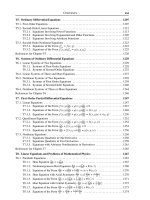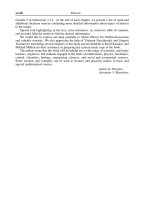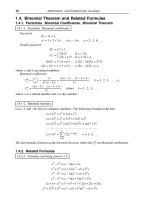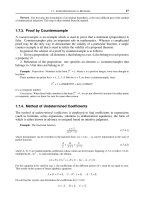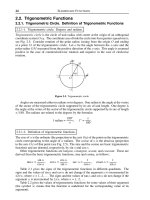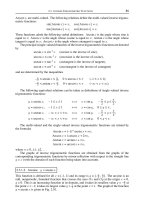Handbook of mathematics discourse
Bạn đang xem bản rút gọn của tài liệu. Xem và tải ngay bản đầy đủ của tài liệu tại đây (2.04 MB, 741 trang )
A Handbook of Mathematical
Discourse
Charles Wells
Case Western Reserve University
Charles Wells
Professor Emeritus of Mathematics
Case Western Reserve University
Affiliate Scholar, Oberlin College
Drawings by Peter Wells
Website for the Handbook:
/>
Copyright c 2003 by Charles Wells
Contents
Preface
v
Introduction
1
Alphabetized Entries
7
Bibliography
281
Index
292
Preface
Overview
This Handbook is a report on mathematical discourse. Mathematical discourse as the phrase is
used here refers to what mathematicians and mathematics students say and write
• to communicate mathematical reasoning,
• to describe their own behavior when doing mathematics, and
• to describe their attitudes towards various aspects of mathematics.
The emphasis is on the discourse encountered in post-calculus mathematics courses taken by math
majors and first year math graduate students in the USA. Mathematical discourse is discussed
further in the Introduction.
The Handbook describes common usage in mathematical discourse. The usage is determined
by citations, that is, quotations from the literature, the method used by all reputable dictionaries. The descriptions of the problems students have are drawn from the mathematics education
literature and the author’s own observations.
This book is a hybrid, partly a personal testament and partly documentation of research. On
the one hand, it is the personal report of a long-time teacher (not a researcher in mathematics
education) who has been especially concerned with the difficulties that mathematics students
have passing from calculus to more advanced courses. On the other hand, it is based on objective
research data, the citations.
The Handbook is also incomplete. It does not cover all the words, phrases and constructions
in the mathematical register, and many entries need more citations. After working on the book
off and on for six years, I decided essentially to stop and publish it as you see it (after lots of
tidying up). One person could not hope to write a complete dictionary of mathematical discourse
in much less than a lifetime.
The Handbook is nevertheless a substantial probe into a very large subject. The citations
accumulated for this book could be the basis for a much more elaborate and professional effort
by a team of mathematicians, math educators and lexicographers who together could produce a
v
definitive dictionary of mathematical discourse. Such an effort would provide a basis for discovering the ways in which students and non-mathematicians misunderstand what mathematicians
write and say. Those misunderstandings are a major (but certainly not the only) reason why so
many educated and intelligent people find mathematics difficult and even perverse.
Intended audience
The Handbook is intended for
• Teachers of college-level mathematics, particularly abstract mathematics at the post-calculus
level, to provide some insight into some of the difficulties their students have with mathematical language.
• Graduate students and upper-level undergraduates who may find clarification of some of the
difficulties they are having as they learn higher-level mathematics.
• Researchers in mathematics education, who may find observations in this text that point to
possibilities for research in their field.
The Handbook assumes the mathematical knowledge of a first year graduate student in
mathematics. I would encourage students with less background to read it, but occasionally they
will find references to mathematical topics they do not know about. The Handbook website
contains some links that may help in finding out about such topics.
Citations
Entries are supported when possible by citations, that is, quotations from textbooks and articles
about mathematics. This is in accordance with standard dictionary practice [Landau, 1989],
pages 151ff. As in the case of most dictionaries, the citations are not included in the printed
version, but reference codes are given so that they can be found online at the Handbook website.
I found more than half the citations on JSTOR, a server on the web that provides on-line
access to many mathematical journals. I obtained access to JSTOR via the server at Case Western
Reserve University.
vi
Acknowledgments
I am grateful for help from many sources:
• Case Western Reserve University, which granted the sabbatical leave during which I prepared
the first version of the book, and which has continued to provide me with electronic and
library services, especially JSTOR, in my retirement.
• Oberlin College, which has made me an affiliate scholar; I have made extensive use of the
library privileges this status gave me.
• The many interesting discussions on the RUME mailing list and the mathedu mailing list.
The website of this book provides a link to those lists.
• Helpful information and corrections from or discussions with the following people. Some
of these are from letters posted on the lists just mentioned. Marcia Barr, Anne Brown,
Gerard Buskes, Laurinda Brown, Christine Browning, Iben M. Christiansen, Geddes Cureton,
Tommy Dreyfus, Susanna Epp, Jeffrey Farmer, Susan Gerhart, Cathy Kessel, Leslie Lamport,
Dara Sandow, Eric Schedler, Annie Selden, Leon Sterling, Lou Talman, Gary Tee, Owen
Thomas, Jerry Uhl, Peter Wells, Guo Qiang Zhang, and especially Atish Bagchi and Michael
Barr.
• Many of my friends, colleagues and students who have (often unwittingly) served as informants or guinea pigs.
vii
Introduction
Note: If a word or phrase is in this typeface then a marginal index
on the same page gives the page where more information about the word
or phrase can be found. A word in boldface indicates that the word is
being introduced or defined here.
In this introduction, several phrases are used that are described in
more detail in the alphabetized entries. In particular, be warned that the
definitions in the Handbook are dictionary-style definitions, not mathematical definitions, and that some familiar words are used with technical
meanings from logic, rhetoric or linguistics.
Mathematical discourse
Mathematical discourse, as used in this book, is the written and spoken language used by mathematicians and students of mathematics for
communicating about mathematics. This is “communication” in a broad
sense, including not only communication of definitions and proofs but
also communication about approaches to problem solving, typical errors,
and attitudes and behaviors connected with doing mathematics.
Mathematical discourse has three components.
• The mathematical register. When communicating mathematical reasoning and facts, mathematicians speak and write in a special register
of the language (only American English is considered here) suitable
for communicating mathematical arguments. In this book it is called
the mathematical register. The mathematical register uses special technical words, as well as ordinary words, phrases and grammatical constructions with special meanings that may be different
from their meaning in ordinary English. It is typically mixed with
expressions from the symbolic language (below).
1
dictionary definition 70
mathematical definition
66
mathematical register 157
register 216
conceptual 43
intuition 161
mathematical register 157
standard interpretation
233
symbolic language 243
• The symbolic language of mathematics. This is arguably not a form
of English, but an independent special-purpose language. It consists
of the symbolic expressions and statements used in calculation and
d
sin x = cos x
presentation of results. For example, the statement dx
is a part of the symbolic language, whereas “The derivative of the
sine function is the cosine function” is not part of it.
• Mathematicians’ informal jargon. This consists of expressions such
as “conceptual proof ” and “intuitive”. These communicate something about the process of doing mathematics, but do not themselves
communicate mathematics.
The mathematical register and the symbolic language are discussed
in their own entries in the alphabetical section of the book. Informal
jargon is discussed further in this introduction.
Point of view
This Handbook is grounded in the following beliefs.
The standard interpretation There is a standard interpretation
of the mathematical register, including the symbolic language, in the
sense that at least most of the time most mathematicians would agree
on the meaning of most statements made in the register. Students have
various other interpretations of particular constructions used in the mathematical register.
• One of their tasks as students is to learn how to extract the standard
interpretation from what is said and written.
• One of the tasks of instructors is to teach them how to do that.
Value of naming behavior and attitudes In contrast to computer people, mathematicians rarely make up words and phrases that
describe our attitudes, behavior and mistakes. Computer programmers’
informal jargon has many names for both productive and unproductive
2
behaviors and attitudes involving programming, many of them detailed
in [Raymond, 1991] (see “creationism”, “mung” and “thrash” for example). The mathematical community would be better off if we emulated
them by greatly expanding our informal jargon in this area, particularly
in connection with dysfunctional behavior and attitudes. Having a name
for a phenomenon makes it more likely that you will be aware of it in
situations where it might occur and it makes it easier for a teacher to tell
a student what went wrong. This is discussed in [Wells, 1995].
Descriptive and Prescriptive
Linguists distinguish between “descriptive” and “prescriptive” treatments
of language. A descriptive treatment is intended to describe the language
as it is used in fact, whereas a prescriptive treatment provides rules for
how the author thinks it should be used. This text is mostly descriptive.
It is an attempt to describe accurately the language used by American
mathematicians in communicating mathematical reasoning as well as in
other aspects of communicating mathematics, rather than some ideal
form of the language that they should use. Occasionally I give opinions
about usage; they are carefully marked as such.
Nevertheless, the Handbook is not a textbook on how to write mathematics. In particular, it misses the point of the Handbook to complain
that some usage should not be included because it is wrong.
Coverage
The words and phrases listed in the Handbook are heterogeneous. The
following list describes the main types of entries in more detail.
Technical vocabulary of mathematics: Words and phrases in
the mathematical register that name mathematical objects, relations or
properties. This is not a dictionary of mathematical terminology, and
3
mathematical object 155
mathematical register 157
property 209
relation 217
apposition 241
context 52
definition 66
disjunction 75
divide 76
elementary 79
equivalence relation 85
formal 99
function 104
identifier 120
if 123
include 127
interpretation 135
labeled style 139
let 140
malrule 150
mathematical education
150
mathematical logic 151
mathematical register 157
mental representation 161
metaphor 162
multiple meanings 169
name 171
noun phrase 177
positive 201
precondition 66
register 216
reification 180
representation 217
symbol 240
term 248
theorem 250
thus 250
type 257
universal quantifier 260
variable 268
most such words (“semigroup”, “Hausdorff space”) are not included.
What are included are words that cause students difficulties and that
occur in courses through first year graduate mathematics. Examples: divide, equivalence relation, function, include, positive. I have also included
briefer references to words and phrases with multiple meanings.
Logical signalers: Words, phrases and more elaborate syntactic
constructions of the mathematical register that communicate the logical
structure of a mathematical argument. Examples: if , let, thus. These
often do not have the same logical interpretation as they do in other
registers of English.
Types of prose: Descriptions of the types of mathematical prose,
with discussions of special usages concerning them. Examples: definitions, theorems, labeled style.
Technical vocabulary from other disciplines: Some technical
words and phrases from rhetoric, linguistics and mathematical logic used
in explaining the usage of other words in the list. These are included
for completeness. Examples: apposition, disjunction, metaphor, noun
phrase, register, universal quantifier.
Warning: The words used from other disciplines often have ordinary
English meanings as well. In general, if you see a familiar word in sans
serif, you probably should look it up to see what I mean by it before you
flame me based on a misunderstanding of my intention! Some words for
which this may be worth doing are: context, elementary, formal, identifier, interpretation, name, precondition, representation, symbol, term,
type, variable.
Cognitive and behavioral phenomena Names of the phenomena connected with learning and doing mathematics. Examples: mental
representation, malrule, reification. Much of this (but not all) is terminology from cognitive science or mathematical education community. It
is my belief that many of these words should become part of mathemati4
cians’ everyday informal jargon. The entries attitudes, behaviors, and
myths list phenomena for which I have not been clever enough to find or
invent names.
Note: The use of the name “jargon” follows [Raymond, 1991] (see
the discussion on pages 3–4). This is not the usual meaning in linguistics,
which in our case would refer to the technical vocabulary of mathematics.
Words mathematicians should use: This category overlaps the
preceding categories. Some of them are my own invention and some come
from math education and other disciplines. Words I introduce are always
marked as such.
General academic words: Phrases such as “on the one hand
. . . on the other hand” are familiar parts of a general academic register
and are not special to mathematics. These are generally not included.
However, the boundaries for what to include are certainly fuzzy, and I
have erred on the side of inclusivity.
Although the entries are of different types, they are all in one list
with lots of cross references. This mixed-bag sort of list is suited to
the purpose of the Handbook, to be an aid to instructors and students.
The “definitive dictionary of mathematical discourse” mentioned in the
Preface may very well be restricted quite properly to the mathematical
register.
The Handbook does not cover the etymology of words listed herein.
Schwartzman [1994] covers the etymology of many of the technical words
in mathematics. In addition, the Handbook website contains pointers to
websites concerned with this topic.
5
attitudes 22
behaviors 25
mathematical education
150
myths 170
register 216
6
abuse of notation
Alphabetized Entries
a, an See indefinite article.
abstract algebra See algebra.
abstraction An abstraction of a concept C is a concept C that
includes all instances of C and that is constructed by taking as axioms
certain assertions that are true of all instances of C. C may already
be defined mathematically, in which case the abstraction is typically a
legitimate generalization of C. In other cases, C may be a familiar concept
or property that has not been given a mathematical definition. In that
case, the mathematical definition may allow instances of the abstract
version of C that were not originally thought of as being part of C.
Example 1 The concept of “group” is historically an abstraction of the
concept of the set of all symmetries of an object. The group axioms are
all true assertions about symmetries when the binary operation is taken
to be composition of symmetries.
Example 2 The -δ definition of continuous function is historically an
abstraction of the intuitive idea that mathematicians had about functions
that there was no “break” in the output. This abstraction became the
standard definition of “continuous”, but allowed functions to be called
continuous that were not contemplated before the definition was introduced.
Other examples are given under model and in Remark 2 under free
variable. See also the discussions under definition, generalization and
representation.
Citations: (31), (270). References: [Dreyfus, 1992], [Thompson,
1985].
7
algebra 9
assertion 20
binary operation 183
composition 40
continuous 54
definition 66
free variable 102
generalization 112
indefinite article 128
mathematical definition
66
mathematical object 155
model 167
output 266
property 209
representation 217
true 256
APOS 17
bar 24
check 36
circumflex 36
compositional 40
fallacy 96
identify 121
mathematical object 155
notation 177
prime 203
suppression of parameters
239
synecdoche 245
tilde 250
variable 268
abuse of notation
affirming the consequent
abuse of notation A phrase used
The phrase “abuse of notation”
to refer to various types of notation appears to me (but not to everythat don’t have compositional seman- one) to be deprecatory or at least
tics. Notation is commonly called abuse apologetic, but in fact some of
of notation if it involves suppression of the uses, particularly suppression
parameters or synecdoche (which over- of parameters, are necessary for
readability. The phrase may be
lap), and examples are given under an imitation of a French phrase,
those headings. Other usage is some- but I don’t know its history. The
times referred to as abuse of notation, English word “abuse” is stronger
for example identifying two structures than the French word “abus”.
along an isomorphism between them. Citations: (82), (210), (399).
Acknowledgments: Marcia Barr
accented characters Mathematicians frequently use an accent to
create a new variable from an old one, usually to denote a mathematical
object with some specific functional relationship with the old one. The
most commonly used accents are bar, check, circumflex, and tilde.
¯ be the closure
Example 1 Let X be a subspace of a space S, and let X
of X in S.
Citations: (66), (178).
Remark 1 Like accents, primes (the symbol ) may be used to denote
objects functionally related to the given objects, but they are also used
to create new names for objects of the same type. This latter appears to
be an uncommon use for accents.
action See APOS.
affirming the consequent The fallacy of deducing P from P ⇒ Q
and Q. Also called the converse error. This is a fallacy in mathematical
reasoning.
8
affirming the consequent
algorithm
Example 1 The student knows that if a function is differentiable, then
it is continuous. He concludes [ERROR] that the absolute value function
is differentiable, since it is clearly continuous.
Citation: (149).
aleph Aleph is the first letter of the Hebrew alphabet, written ℵ. It
is the only Hebrew letter used widely in mathematics. Citations: (182),
(183), (315), (383).
algebra This word has several different meanings in the school system
of the USA, and college math majors in particular may be confused by
the differences.
• High school algebra is primarily algorithmic and concrete in nature.
• College algebra is the name given to a college course, perhaps
remedial, covering the material covered in high school algebra.
• Linear algebra may be a course in matrix theory or a course in
linear transformations in a more abstract setting.
• A college course for math majors called algebra, abstract algebra,
or perhaps modern algebra, is an introduction to groups, rings,
fields and perhaps modules. It is for many students the first course
in abstract mathematics and may play the role of a filter course. In
some departments, linear algebra plays the role of the first course in
abstraction.
• Universal algebra is a subject math majors don’t usually see until
graduate school. It is the general theory of structures with n-ary
operations subject to equations, and is quite different in character
from abstract algebra.
algorithm An algorithm is a specific set of actions that when carried
out on data (input) of the allowed type will produce an output. This is
9
algorithm
mathematical definition
66
mathematical discourse 1
mathematical object 155
proof 205
algorithm
the meaning in mathematical discourse. There are related meanings in
use:
• The algorithm may be implemented as a program in a computer
language. This program may itself be referred to as the algorithm.
• In texts on the subject of algorithm, the word may be given a mathematical definition, turning an algorithm into a mathematical object
(compare the uses of proof ).
Example 1 One might express a simpleminded algorithm for calculating a zero of a function f (x) using Newton’s Method by saying
f (x)
“Start with a guess x and calculate x −
repeatedly until
f (x)
f (x) gets sufficiently close to 0 or the process has gone on too
long.”
One could spell this out in more detail this way:
1. Choose an accuracy , the maximum number of iterations N , and a
guess s.
2. Let n = 0.
3. If |f (s)| < then stop with the message “derivative too small”.
4. Replace n by n + 1.
5. If n > N , then stop with the message “too many iterations”.
f (s)
6. Let r = s −
.
f (s)
7. If |f (r)| < then stop; otherwise go to step 3 with s replaced by r.
Observe that neither description of the algorithm is in a programming language, but that the second one is precise enough that it could be
translated into most programming languages quite easily. Nevertheless,
it is not a program.
Citations: (77), (98).
10
algorithm
algorithm
Remark 1 It is the naive concept of abstract algorithm given in the alias 12
preceding examples that is referred to by the word “algorithm” as used in APOS 17
converse 87
mathematical discourse, except in courses and texts on the theory of algo- function 104
rithms. In particular, the mathematical definitions of algorithm that have mathematical definition
been given in the theoretical computing science literature all introduce 66
a mass of syntactic detail that is irrelevant for understanding particular mathematical discourse 1
overloaded notation 189
algorithms, although the precise syntax may be necessary for proving the- process 17
orems about algorithms, such as Turing’s theorem on the existence of a syntax 246
noncomputable function.
Example 2 One can write a program in Pascal and An “algorithm” in the meaning given here
another one in C to take a list with at least three en- appears to be a type of process as that word
tries and swap the second and third entries. There is a is used in the APOS description of mathsense in which the two programs, although different as ematical understanding. Any algorithm fits
programs, implement the “same” abstract algorithm. their notion of process, but whether the converse is true or not is not clear.
The following statement by Pomerance [1996]
(page 1482) is evidence for this view on the use of the word “algorithm”:
“This discrepancy was due to fewer computers being used on the project
and some ‘down time’ while code for the final stages of the algorithm was
being written.” Pomerance clearly distinguishes the algorithm from the
code.
Remark 2 Another question can be raised concerning Example 2. A
computer program that swaps the second and third entries of a list might
do it by changing the values of pointers or alternatively by physically moving the entries. (Compare the discussion under alias). It might
even use one method for some types of data (varying-length data such as
strings, for example) and the other for other types (fixed-length data).
Do the two methods still implement the same algorithm at some level of
abstraction?
See also overloaded notation.
Acknowledgments: Eric Schedler, Michael Barr.
11
algorithm addiction
algorithm 9
attitudes 22
conceptual 43
group 34
guessing 119
look ahead 149
proof 205
trial and error 253
alias
algorithm addiction Many students have the attitude that a problem must be solved or a proof constructed by an algorithm. They become quite uncomfortable when faced with problem solutions that involve
guessing or conceptual proofs that involve little or no calculation.
Example 1 Recently I gave a problem in my Theoretical Computer
Science class that in order to solve it required finding the largest integer
n for which n! < 109 . Most students solved it correctly, but several wrote
apologies on their paper for doing it by trial and error. Of course, trial
and error is a method.
Example 2 Students at a more advanced level may feel insecure in
the case where they are faced with solving a problem for which they
know there is no known feasible algorithm, a situation that occurs mostly
in senior and graduate level classes. For example, there are no known
feasible general algorithms for determining if two finite groups given by
their multiplication tables are isomorphic, and there is no algorithm at
all to determine if two presentations (generators and relations) give the
same group. Even so, the question, “Are the dihedral group of order 8
and the quaternion group isomorphic?” is not hard. (Answer: No, they
have different numbers of elements of order 2 and 4.) I have even known
graduate students who reacted badly to questions like this, but none of
them got through qualifiers!
See also Example 1 under look ahead and the examples under conceptual.
alias The symmetry of the square illustrated by the figure below can
be described in two different ways.
12
alias
all
A.
.B
D.
.A
=⇒
.
.
.
.
D
C
C
B
a) The corners of the square are relabeled, so that what was labeled
A is now labeled D. This is called the alias interpretation of the
symmetry.
b) The square is turned, so that the corner labeled A is now in the upper
right instead of the upper left. This is the alibi interpretation of the
symmetry.
Reference: These names are from [Birkhoff and Mac Lane, 1977].
They may have appeared in earlier editions of that text.
See also permutation.
Acknowledgments: Michael Barr.
alibi See alias.
all Used to indicate the universal quantifier. Examples are given under
universal quantifier.
Remark 1 [Krantz, 1997], page 36, warns against using “all” in a sentence such as “All functions have a maximum”, which suggests that every
function has the same maximum. He suggests using each or every instead.
(Other writers on mathematical writing give similar advice.) The point
here is that the sentence means
∀f ∃m(m is a maximum for f )
not
∃m∀f (m is a maximum for f )
See order of quantifiers and esilism. Citation: (333).
13
alias 12
each 78
esilism 87
every 261
order of quantifiers 186
permutation 197
sentence 227
universal quantifier 260
all
all 13
assertion 20
citation vi
collective plural 37
every 261
mathematical object 155
mathematical structure
159
never 177
space 231
time 251
universal quantifier 260
variable 268
ambient
I have not found a citation of the form “All X have a Y” that does
mean every X has the same Y , and I am inclined to doubt that this is
ever done. (“All” is however used to form a collective plural – see under
collective plural for examples.) This does not mean that Krantz’s advice
is bad.
always Used in some circumstances to indicate universal quantification. Unlike words such as all and every, the word “always” is attached
to the verb instead of to the noun being quantified..
Example 1 “x2 + 1 is always positive.” This means, “For every x,
x2 + 1 is positive.”
Example 2
“An ellipse always has bounded curvature.”
Remark 1 In print, the usage is usually like Example 2, quantifying
over a class of structures. Using “always” to quantify over a variable
appearing in an assertion is not so common in writing, but it appears to
me to be quite common in speech.
Remark 2 As the Oxford English Dictionary shows, this is a very old
usage in English.
See also never, time.
Citations: (116), (155), (378), (424).
ambient The word ambient is used to refer to a mathematical object
such as a space that contains a given mathematical object. It is also
commonly used to refer to an operation on the ambient space.
Example 1 “Let A and B be subspaces of a space S and suppose φ is
an ambient homeomorphism taking A to B.”
The point is that A and B are not merely homeomorphic, but they
are homeomorphic via an automorphism of the space S.
Citations: (223), (172).
14
analogy
and
analogy An analogy between two situations is a perceived similarity
between some part of one and some part of the other. Analogy, like
metaphor, is a form of conceptual blend.
Mathematics often arises out of analogy: Problems are solved by
analogy with other problems and new theories are created by analogy
with older ones. Sometimes a perceived analogy can be put in a formal
setting and becomes a theorem.
Analogy in problem solving is discussed in [Hofstadter, 1995].
and
(a) Between assertions The word “and” between two assertions P and Q produces the conjunction of P and Q.
Example 1 The assertion
“x is positive and x is less than 10.”
is true if both these statements are true: x is positive, x is less
than 10.
An argument by analogy is the
claim that because of the similarity between certain parts there must
also be a similarity between some
other parts. Analogy is a powerful
tool that suggests further similarities; to use it to argue for further
similarities is a fallacy.
(b) Between verb phrases The word “and” can also be used between
two verb phrases to assert both of them about the same subject.
Example 2 The assertion of Example 1 is equivalent to the assertion
“x is positive and less than 10.”
See also both. Citations: (23), (410).
(c) Between noun phrases The word “and” may occur between two
noun phrases as well. In that case the translation from English statement
to logical assertion involves subtleties.
Example 3 “I like red or white wine” means “I like red wine and I like
white wine”. So does “I like red and white wine”. But consider also “I
like red and white candy canes”!
15
assertion 20
both 29
conceptual blend 45
conjunction 50
fallacy 96
metaphor 162
noun phrase 177
or 184
positive 201
theorem 250
true 256
and
coreference 59
eternal 155
juxtaposition 138
mathematical discourse 1
mathematical logic 151
mathematical object 155
or 184
translation problem 253
and
Example 4 “John and Mary go to school” means the same thing as
“John goes to school and Mary goes to school”. “John and Mary own a
car” (probably) does not mean “John owns a car and Mary owns a car”.
On the other hand, onsider also the possible meanings of “John and
Mary own cars”. Finally, in contrast to Examples 3 and 5, “John or Mary
go to school” means something quite different from “John and Mary go
to school.”
Example 5 In an urn filled with balls, each of a single color, “the set
of red and white balls” is the same as “the set of red or white balls”.
Terminology In mathematical logic, “and” may be denoted by “∧” or
“&”, or by juxtaposition.
See also the discussion under or.
Difficulties The preceding examples illustrate that mnemonics of the
type “when you see ‘and’ it means intersection” cannot work ; the translation problem requires genuine understanding of both the situation being
described and the mathematical structure.
In sentences dealing with physical objects, “and” also may imply
a temporal order (he lifted the weight and dropped it, he dropped the
weight and lifted it), so that in contrast to the situation in mathematical
assertions, “and” is not commutative in talking about physical objects.
That it is commutative in mathematical discourse may be because mathematical objects are eternal.
As this discussion shows, to describe the relationship between English sentences involving “and” and their logical meaning is quite involved
and is the main subject of [Kamp and Reyle, 1993], Section 2.4. Things
are even more confusing when the sentences involve coreference, as examples in [Kamp and Reyle, 1993] illustrate.
16
and
APOS
Acknowledgments: The examples given above were suggested by
those in the book just referenced, those in [Schweiger, 1996], and in comments by Atish Bagchi and Michael Barr.
angle bracket Angle brackets are the symbols “ ” and “ ”. They
are used as outfix notation to denote various constructions, most notably
an inner product as in v, w .
Terminology Angle brackets are also called pointy brackets, particularly in speech.
Citations: (81), (171), (293), (105).
anonymous notation See structural notation.
antecedent The hypothesis of a conditional assertion.
antiderivative See integral.
any Used to denote the universal quantifier; examples are discussed
under that heading. See also arbitrary.
APOS The APOS description of the way students learn mathematics
analyzes a student’s understanding of a mathematical concept as developing in four stages: action, process, object, schema.
I will describe these four ideas in terms of computing the value of a
function, but the ideas are applied more generally than in that way. This
discussion is oversimplified but, I believe, does convey the basic ideas in
rudimentary form. The discussion draws heavily on [DeVries, 1997].
A student’s understanding is at the action stage when she can carry
out the computation of the value of a function in the following sense:
after performing each step she knows how to carry out the next step.
The student is at the process stage when she can conceive of the
process as a whole, as an algorithm, without actually carrying it out. In
17
algorithm 9
arbitrary 18
conditional assertion 47
hypothesis 47
integral 133
outfix notation 188
structural notation 235
symbol 240
universal quantifier 260



